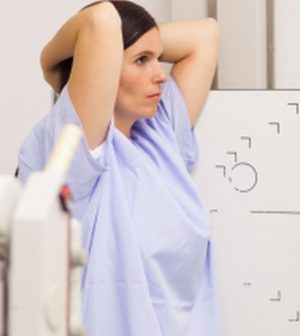- See What Saffron Can Do for Sleep and Heart Health
- 6 Common Mistakes to Avoid Before Your Physical
- Can Sweating Really Help You Beat a Cold?
- Strengthening Your Relationship: Practical Strategies
- Skip Storing This Everyday Product in the Fridge Door
- Green Tea + B3 Pairing May Boost Brain Health
- Navigating Your Midlife Crisis: Embracing New Possibilities
- City Raccoons Showing Signs of Domestication
- Mapping the Exposome: Science Broadens Focus to Environmental Disease Triggers
- One Week Less on Social Media Linked to Better Mental Health
Ultrasound Good Diagnostic Tool After Breast Symptoms

For women with “focal breast complaints” — issues with pain, lumps or discharge — ultrasound is an effective diagnostic tool, according to new research.
These concerns are frequent, and ultrasound is effective as a standalone diagnostic method, researchers report April 4 in the journal Radiology.
“The evaluation of breast complaints is a common problem in breast diagnostics,” said study co-author Dr. Linda Appelman, a breast radiologist at Radboud University Medical Center in Nijmegen, the Netherlands.
“Ultrasound as the first imaging method may provide clarity with regard to the focal breast complaint,” Appelman added in a journal news release.
About 70,000 women in the Netherlands, many of them between 30 and 50 years old, go to radiology departments with these issues each year.
Digital breast tomosynthesis (DBT) followed by targeted ultrasound is the standard diagnostic tool for women 30 years or older with these concerns.
DBT — sometimes called 3D mammography — provides an overall image of both breasts, while ultrasound can offer more targeted imaging of a specific area. Image quality has vastly improved in recent years, the study notes.
Researchers studied the cases of 1,961 women with these concerns at three hospitals in the Netherlands between September 2017 and June 2019.
Targeted ultrasound was evaluated first, followed by DBT.
Ultrasound alone led to accurate diagnosis in 90% of the patients. More than 80% of the complaints ended with normal or benign findings, such as cysts.
“We found that the diagnostic accuracy of ultrasound is high in women with focal breast complaints,” Appelman said.
Based on ultrasound findings alone, 374 patients had biopsies. Among them were 192 who received a breast cancer diagnosis.
Using ultrasound for focal breast complaints may be especially beneficial in low- or middle-income countries where it is more readily available than DBT, the authors said.
“Our study showed that ultrasound alone can effectively diagnose focal breast complaints in a large majority of women,” Appelman said. “In a setting with limited resources or an already existing screening program, initial ultrasound might be a better alternative compared to mammography.”
Cost-effectiveness and improved patient comfort are other considerations.
More information
The American Cancer Society has more on breast cancer and non-cancerous breast conditions.
SOURCE: Radiology, news release, April 4, 2023
Source: HealthDay
Copyright © 2025 HealthDay. All rights reserved.










